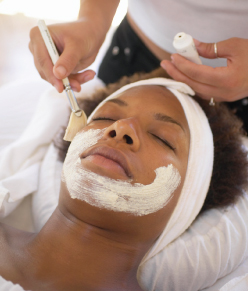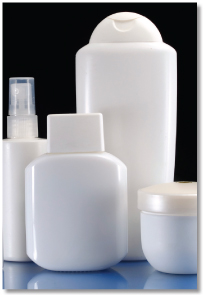 Liabilities
Liabilities
First and foremost, correct product choice begins with an understanding of the dermal sciences and how the cells and systems function within the epidermis and dermis. Without this core knowledge, we increase our liability when it comes to recommending a product or service. As practitioners we must be aware that our hands-on work in our treatment room, retail sales, and what we say when advising a client all have liability factors attached to them. As a skin care professional, you are wholly responsible for making an educated decision when performing services on your clients. This responsibility also elicits the desire to become as educated as possible with your cosmetic chemistry (ingredients), the dermal sciences, and assessment methodology.
Manufacturers carry liability insurance with their products. They should also have an education and customer support department whose focus is to support their wholesale customers. Additionally, your business liability insurance should cover your services, your products and place of business. Even if you do not own the business, you should still have liability insurance to ensure you are adequately protected for your hands-on services. According to the Associated Skin Care Professionals (ASCP), some of the biggest claims have been waxing (Brazilian) as well as chemical peels and IPL.1 You are ultimately responsible for making good decisions within your practice to mitigate any potential misunderstandings and/or potential lawsuits. This liability can be far reaching as your client leaves your place of business and shares his or her experience with family and friends. We do not have control over a client once they leave our practice. Consequently, it is essential that you take the time to educate not only yourself but also your client. Discuss all options as you advise the care of his or her skin. Potential liabilities can be mitigated by how we interact with each client in our first meeting as well as in subsequent visits. A poor or hasty initial assessment or performing too aggressive of a treatment can easily increase potential liability. Subsequent appointments require that you check with your client concerning any changes in their health or home care regimen since the last visit.
DERMASCOPE asked three major professional skin care brands to provide insight on the following question: As a manufacturer of professional skin care products, what is your company’s policy regarding a customer having a client experience an adverse reaction to a particular product?
"While we formulate Lexli skin care products using the highest quality ingredients, the reality is that reactions can occur. When they do, our primary goal is to minimize client discomfort by providing the aesthetician with various recommendations intended to alleviate the situation. We then strive to learn from the experience by working with the aesthetician to deconstruct the details surrounding the client's use of our products. Reasons for a reaction are as varied as the ways in which the reaction may present. Therefore, we attempt to understand each step taken by the aesthetician during treatment. Did the reaction occur following a facial? What specific product use instructions did the aesthetician give the client? Did the reaction occur following at-home use of our products? Additionally, we provide aestheticians with a list of questions to ask their client to determine how long each product was used, the manner in which they've been incorporated into the skin care routine, other products that were used simultaneously, and any other circumstances that could impact results, such as sun exposure. Most often, we are able to pinpoint the cause, such as improper education about common ways in which the skin adjusts to exfoliation. When we are not able to identify client or aesthetician error as a cause, we try to replicate the reaction in the lab so we may determine if formulation modifications are necessary."
Ahmed Abdullah, M.D., F.A.C.S., F.I.C.S., founder and lead formulator of Lexli, Inc.

"As a manufacturer of cosmetics, particularly functional cosmetics and cosmeceuticals, it's very important to educate professionals during our seminars about the heightened awareness that should be taken with clients today. This means going deeper into a proper skin diagnosis and being sensitized to the client's skin type, condition, product use, age, lifestyle, diet, health, et cetera. Even if the skin type and condition is similar, one could need entirely different solutions and products. For example, hyperpigmentation with acne needs to be treated differently than hyperpigmentation and sun-damage. A proper analysis and diagnosis needs to be done on a regular basis, to accommodate with the changes life brings such as aging, seasons, illness, diet, stress, et cetera. Is there a need for a change in the skin regimen? A common problem today in our product-oriented, quick fix society is to ask, "Is my client on product overload?" The skin might need a detox when too much is simply too much. Today it's more and more common to encounter allergic or sensitized skin, which leads us to ask more questions of its source(s) in our diagnosis, so that we can find the proper solution to calm and balance the skin and, most importantly, the client. When we can make a connection between our clients and their skin and not products and retail, we can generate a solutions-oriented perspective in which we can abate problems, generate trust, educate and convincingly bring your client back again."
Katharina Dieser, CEO of Alex Cosmetic Germany
 "The most proactive policy toward dealing with an adverse reaction is to avoid its occurrence in the first place. This starts with educating the professional. Clarity on the use of the product is the first place we start, ensuring that each product is being used correctly on an appropriate individual. Know your product. Know your client.
"The most proactive policy toward dealing with an adverse reaction is to avoid its occurrence in the first place. This starts with educating the professional. Clarity on the use of the product is the first place we start, ensuring that each product is being used correctly on an appropriate individual. Know your product. Know your client.
It is essential that practitioners understand the nature and function of those active ingredients with the potential for skin reactions. Vitamin A, alpha and beta hydroxy acids, and exfoliating agents provide great benefits for the appropriate skin type. Conversely, because of their activity, they are often the culprits associated with skin reactions. The number of ingredients available to manufacturers, from botanical and synthetic sources, has exploded in recent years, increasing the potential for cross-reactions from ingredient combinations. Client intake forms must include a comprehensive medical history, particularly all known allergies, and past negative experiences with products, foods or medications. Repeating these questions when filling out the consent form with your client can help to prevent adverse reactions from occurring.
As a manufacturer, it is our policy to require thorough product knowledge training for all practitioners using Circadia. That said, we understand that mistakes happen. Let's use the extreme example of retailing a salicylic acid cleansing gel to a rosacea-prone client, causing a visible and uncomfortable reaction. The client must be seen immediately by both the selling and servicing professional. To alleviate the symptoms, our customers are provided with emergency phone access to their representative and an educator who, if necessary, will contact the company CEO.
In order to not deter the client completely from the use of a brand because it was misrepresented at the time of sale, the return should be processed immediately, and another appointment should be booked, free of charge, to follow up and ensure the proper selection of products appropriate for that client."
Michael Q. Pugliese, L.E., CEO of Circadia by Dr. Pugliese, Inc.
Synergist Relationships
There should be a collaborative relationship between your choice of in-clinic treatments and home care recommendations. Ingredients must honor and support the cells and barrier function by assisting the skin in its ability to self-repair. The latest research indicates that keratinocytes are the chief communicators in the skin.2 They rule and send out thousands of signals not only throughout the epidermis, but the dermis as well. The slightest activity even on the acid mantle begins to send signals throughout the skin. After all, it is our first line of defense. Any treatments or product application should not create an excessive immune response, especially in skin that is already compromised. Furthermore, we now know that fibroblasts (collagen and elastin) can be stimulated through treatment performance on the epidermis.3
A closer inspection of the natural nutrients within the cells and their membranes, the mitochondria, the barrier, the dermal/epidermal junction, and the dermis components provide a clue as to what ingredients will show compatibility to the skin. Skin care products should be prepared with mimetic agents that compliment the skin.4 For example, the dermal membrane structure in the barrier layers of the stratum corneum consists of ceramides, cholesterol and palmitic acid.5 They are naturally found within the skin bilayers that are responsible for maintaining the natural moisturizing factors (NMF) and continued regenerating of a strong skin defense. A resilient barrier increases the probability that the underlying skin structures are able to function correctly. Based on the research of Professor A. Kligman, moisturizing substances may contribute to stabilizing the skin barrier leading to proper functioning.6 He called it Corneotherapy: "outside to inside" therapy. Be mindful that many emulsifying agents may end up having a wash out affect on the skin, dissolving ingredients of creams along with the natural skin lipids out of the skin.7
Furthermore, ingredients should be compatible for correcting a current skin condition with an emphasis on prevention and optimum health. For example, in highly sensitive, flared (inflamed) skin including rosacea, eczema and psoriasis, each condition experiences a high transepidermal water loss (TEWL) that causes susceptibility for penetration of external substances such as microorganisms (fungi, bacteria and viruses). As a result, the barrier function is impaired. The stratum corneum exhibits a deficiency in ceramide-1 (linoleic acid), a main barrier component of the skin.8 Certain skin conditions also have enzyme deficiencies that further inhibit the natural transformation of linoleic acid into gamma-linoleic acid, a natural component in the cell membrane. The application of ingredients such as phosphatidylcholine, evening primrose, vitamin A, linoleic acid, ceramides, boswellia, triglycerides green tea, butchers broom, echinacea and D-panthenol may all help support the barrier function and calm reactive skin.

The Biological Theories on Aging
Let us explore the numerous theories of why an individual actually ages. We will address two main theories because this information provides key evidence and clues regarding the condition and extent of cellular damage. This information is relevant to how you will proceed in your treatment programs and the probability for results.
Molecular and Genetic Theories
Humans are born with genetic encoding that predetermines physical and mental functioning.9 Genes determine the rate of aging and length of life. Scientific studies suggest, however, that only about 25 percent of our life expectancy is determined by our genes. The rest of the 75 percent depends upon our overall environment, lifestyles and the daily choices we make including our thoughts, exercise and activity, and good food choices.10
Cellular Theories
When determining the rate by which an individual ages, we should be aware of the underlying levels of cellular aging (biological aging); it is very different than chronological aging. We may be 40, however, due to our lifestyle and amount of environmental exposure, especially to the sun, there can be an acceleration of cellular aging. Therefore, our cells may really be 10 years older!
There are five levels of cellular damage that can steadily begin in our earlier years.11 The rate at which this occurs manifests in our skin, which is a billboard for our internal health. Depending upon the level of biological aging, the skin may show deep wrinkles, become mottled (blotchy), look thinner, sag, and lackluster.
 Lipid Peroxidation and Oxidative Stress (free radicals) – Free radicals attack cell membranes and end up cross-linking proteins and lipids to create substances known as lipofuscins.9 Oxidative stress begins early in life. Normally our body has the capacity for cellular repair. This ability becomes reduced, however, based on the accumulative effect of oxidative stress and also our age. Eventually, it affects the cellular DNA impairing cellular function leading to cellular senescence or even cancer.
Lipid Peroxidation and Oxidative Stress (free radicals) – Free radicals attack cell membranes and end up cross-linking proteins and lipids to create substances known as lipofuscins.9 Oxidative stress begins early in life. Normally our body has the capacity for cellular repair. This ability becomes reduced, however, based on the accumulative effect of oxidative stress and also our age. Eventually, it affects the cellular DNA impairing cellular function leading to cellular senescence or even cancer.
Mitochondria DNA Damage – Accumulative damage can move to the mitochondria that is the cell's energy source. Mitochondria are responsible for various cellular activities including the oxidation of food molecules to produce Adenosine Triphosphate (ATP), a molecular energy source.4 The high activity of the mitochondria naturally leads to the formation of damaging free radical injury (ROS). Their metabolic activity consumes most of the oxygen you breathe. Furthermore, they lack the repair mechanisms found in other parts of the cell.9 Be mindful that whenever there are metabolic biochemical reactions in the body, there is a certain amount of oxidative stress (free radical activity). It is the excess accumulation of this activity that accelerates premature cellular aging.
Mitochondrial Aging and Cellular Senescence – When there is excessive oxidative damage and the mitochondria no longer functions properly, this eventually causes malfunction throughout the entire cell. DNA becomes damaged by numerous environmental assaults, which leads to forming cell mutations during cell mitosis (division). The repair mechanisms cannot keep up with the rate of damage and the cell ends up going into a state of senescence. This state can also lead to cancer. Researchers also confirm that there are over 28 diseases related to mitochondrial damage and biological aging.9, 11
The Analysis
Your first appointment with a new client should be the consultation. A paid service, it is the first point of reference for finding the leading causes of a skin condition and should not be bypassed. This critical service allows you to completely assess your client's skin, build credibility as a professional, and demonstrate that you are a serious, well-educated aesthetician who understands the skin. More over the hour you spend thoroughly assessing your client's skin reduces future liability when you are actually performing treatments and recommending home care. During this consultation, your client's skin health is evaluated and you have established a clearer pathway for the probability of success during recommended treatments. Furthermore, this appointment provides you the necessary time to establish the leading causes of your client's skin condition. It is important to establish the level of damage within the skin because it provides the information for potential risks and probability of correction when laying out a pathway of corrective treatments. Most important, you also may note that there are anomalies on their skin that require medical intervention for further consideration.
The skin analysis includes a written intake form along with the use of modern electronic skin analyzing aids that can provide you with a more accurate reading of the client's hydration level, sebum (lipids), melanin (the risk for pigmentation), and level of erythema. Taking photos is also recommended.
At the end of the consultation, summarize the leading causes of their skin condition(s) and create a treatment plan of action prioritizing the client's clinical treatments and home care – including holistic wellness. Furthermore, make sure to mention any skin anomalies that may require professional referral.
 Client Health Review
Client Health Review
Every question on your intake form becomes part of the scaffolding for building a comprehensive picture of your client's skin along with expectations. It also initiates potential factors that you have to assess as you set up a program of correction. Each section tells a story about your client's skin health and the condition of the skin from a cellular perspective. In addition, it also assists in determining the levels of damage within the skin itself.
Essentially your treatment program should be based around this assessment:
- Is the damage within the stratum corneum and the skin barrier?
- Is it in the spinosum, the dermal/epidermal junction, the melanocytes, or further down into the facia septa (dermis)?
Contemporary skin challenges require us to understand the microscopic world of cells. The rate and ability for skin correction is influenced by intrinsic and extrinsic factors that must be understood in order to create educated choices for treatments and products. The outcome of a treatment is also dependent upon the body's ability to respond. There is no room for guessing. Newer paradigm shifts in skin treatments beckon us to become educated in order to make appropriate decisions within our practice. There are innovative formulations and technologies that may also increase the liability within our practices. We must also be savvy enough to embrace the concept that a specific skin condition and/or treatment may be out of the scope of our licensing and requires referral to a medical professional. It is our responsibility to continue our education to upgrade our knowledge and skills.
 References
References
1.Associated Skin Care Professionals report. www.ascp.com
2.Setterfield, L. (2010). The Concise Guide: Dermal Needling – Medical Edition. Two-year study. Virtual Beauty, New Zealand. p 6
3.Elias, P.M, Feingold, K.R. (2006). Skin Barrier. Taylor & Francis
4.Barrett-Hill, F. (2009). Advanced Skin Analysis. Virtual Beauty, New Zealand. Online course: www.pastiche.net.nz
5.Barrett-Hill, F. (2009). Cosmetic Chemistry. Virtual Beauty, New Zealand. www.pastiche.net.nz
6.Elias, P.M, Feingold, K.R. (2006). Skin Barrier: Chapter 3 by Albert M. Kligman - "A Brief History of How the Dead Stratum Corneum Became Alive." Taylor & Francis.
7.Lautenschläger, H. (2001). Neurodermatitis – specific prevention. Kosmetik International (11), 44-47
8.Lautenschläger, H. (2010). Corneotherapeutic skin care for the rosacea skin. "Äesthetische Dermatologie" (mdm Verlag) (3), 16-20.
9.Pugliese, Peter T., M.D.; (2005). Advanced Professional Skin Care – Medical Edition. The Topical Agent, LLC., Bernville, PA pp 244-246
10.Zani, A.J. (June 2011). "Timeless Traditions… Healthy Life." Dermascope p 77
11.Barrett-Hill, Florence (2005). Advanced Skin Analysis. Virtual Beauty. Online course: www.pastiche.net.nz
12.Pugliese, Peter T., M.D.; (2005) Advanced Professional Skin Care.- Medical Edition. The Topical Agent, LLC.; Bernville, PA. pp 247-248
 Alexandra J. Zani is an international post-graduate education, scientific researcher with a background in biology and medical technology. She holds numerous advanced certifications including skin analysis, cosmetic chemistry, aesthetic technologies, and Oncology Esthetics™. As an author she is a book co-author, a contributing writer for textbooks and industry publications. Zani holds a teaching license, is NCEA nationally certified and serves as a technical and scientific advisor for postgraduate studies and formulations. Her focus is on the aging sciences, treatment modalities incorporating aesthetic technologies, the health effects of nutrition and lifestyle, and the importance of the mind-body connection.
Alexandra J. Zani is an international post-graduate education, scientific researcher with a background in biology and medical technology. She holds numerous advanced certifications including skin analysis, cosmetic chemistry, aesthetic technologies, and Oncology Esthetics™. As an author she is a book co-author, a contributing writer for textbooks and industry publications. Zani holds a teaching license, is NCEA nationally certified and serves as a technical and scientific advisor for postgraduate studies and formulations. Her focus is on the aging sciences, treatment modalities incorporating aesthetic technologies, the health effects of nutrition and lifestyle, and the importance of the mind-body connection.
Want to read more?
Subscribe to one of our monthly plans to continue reading this article.